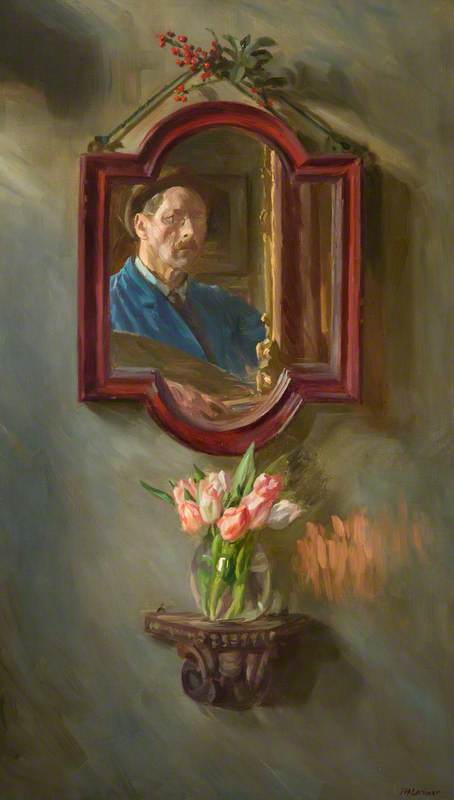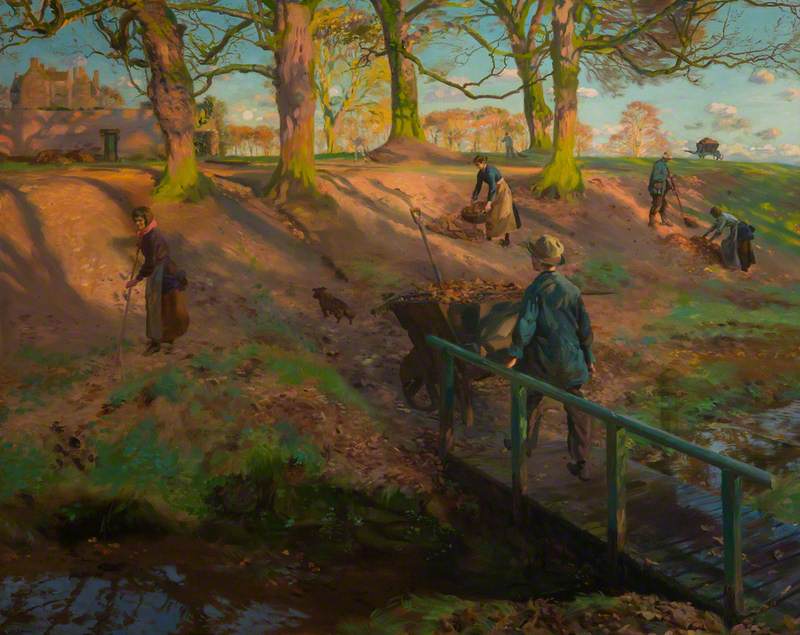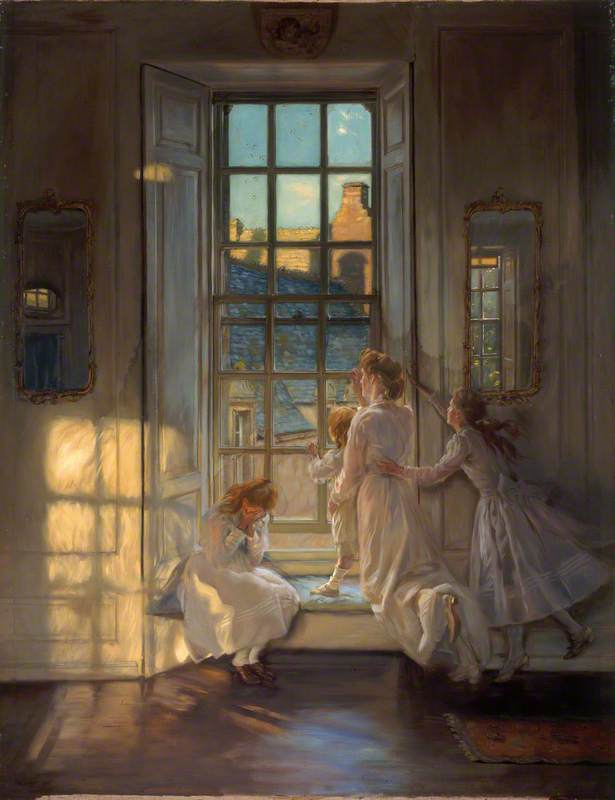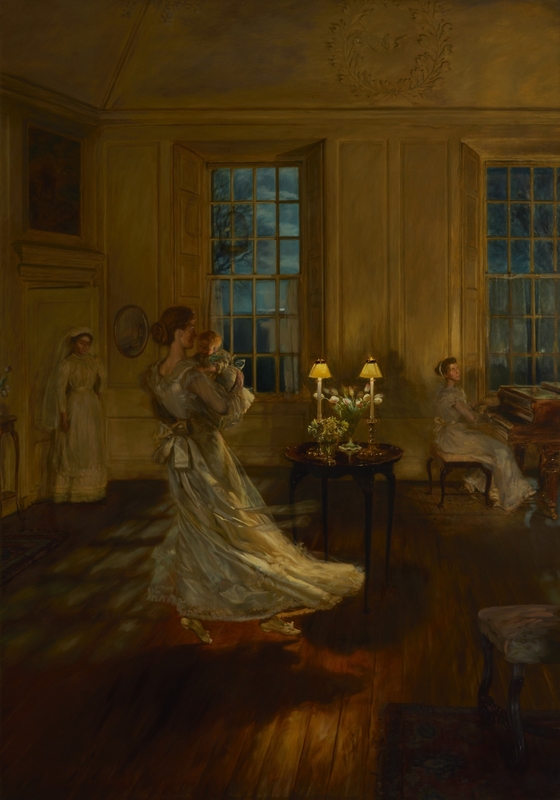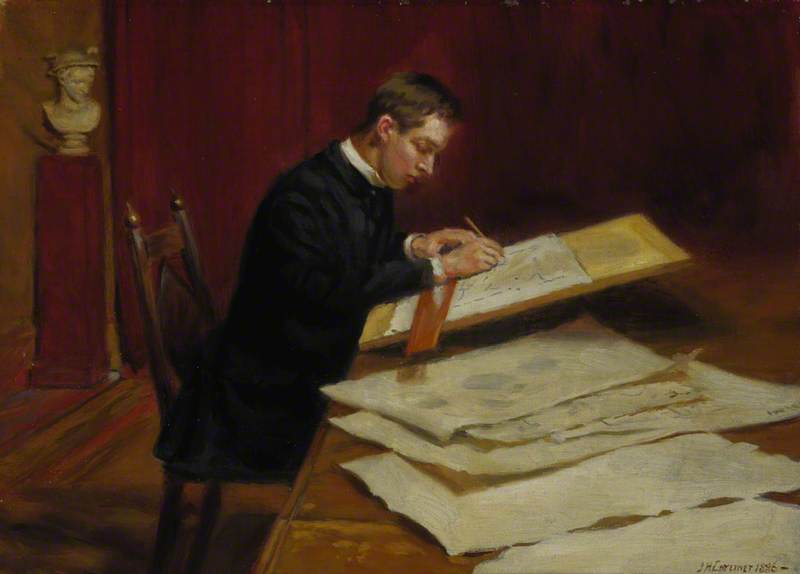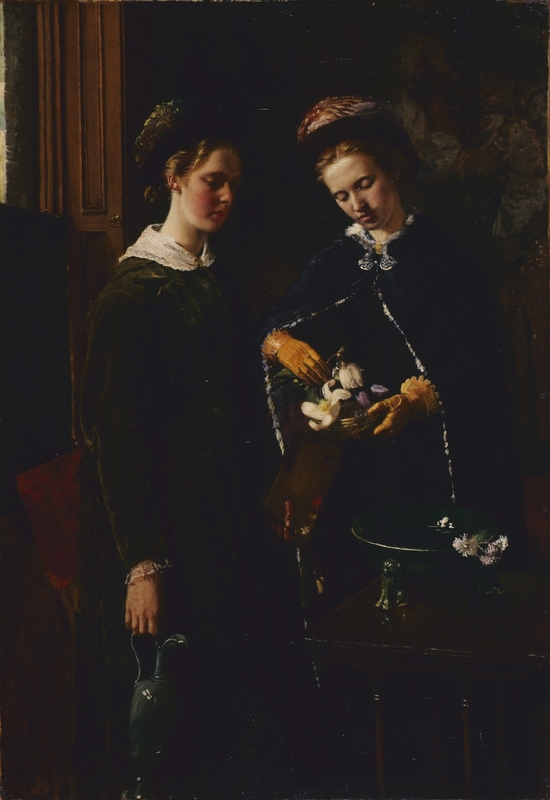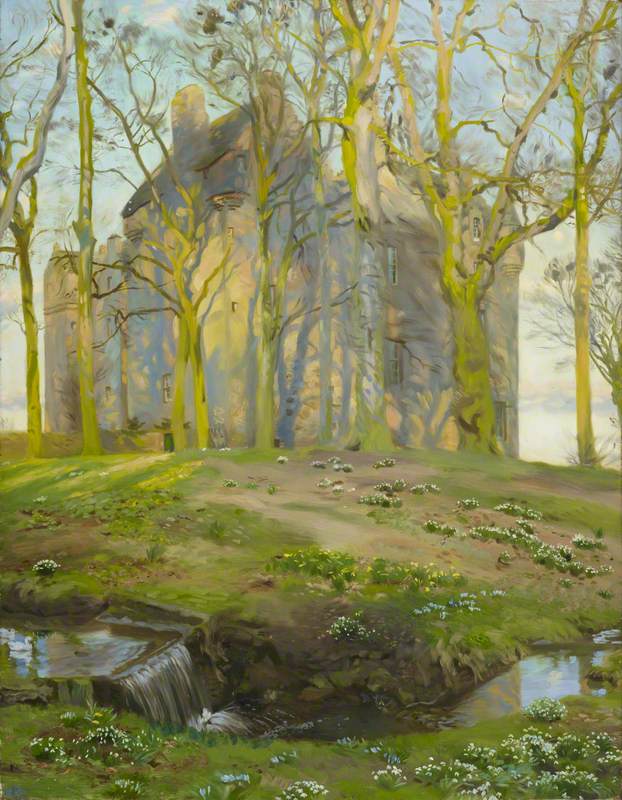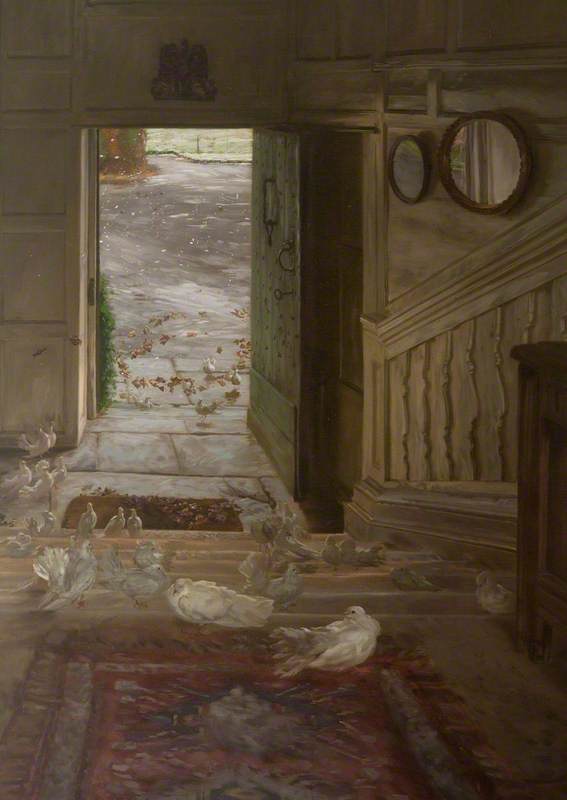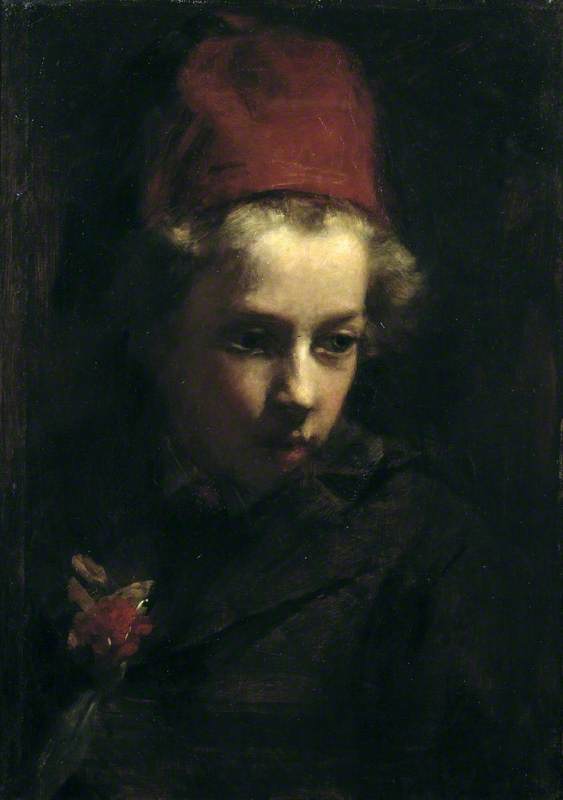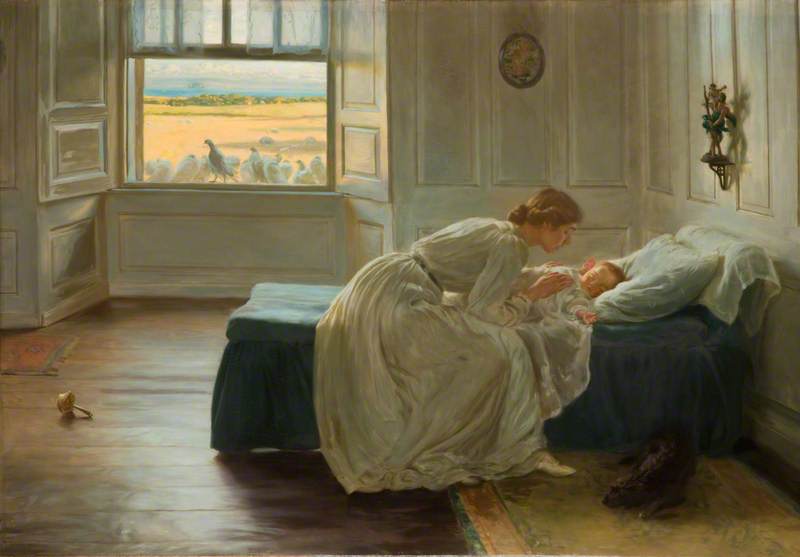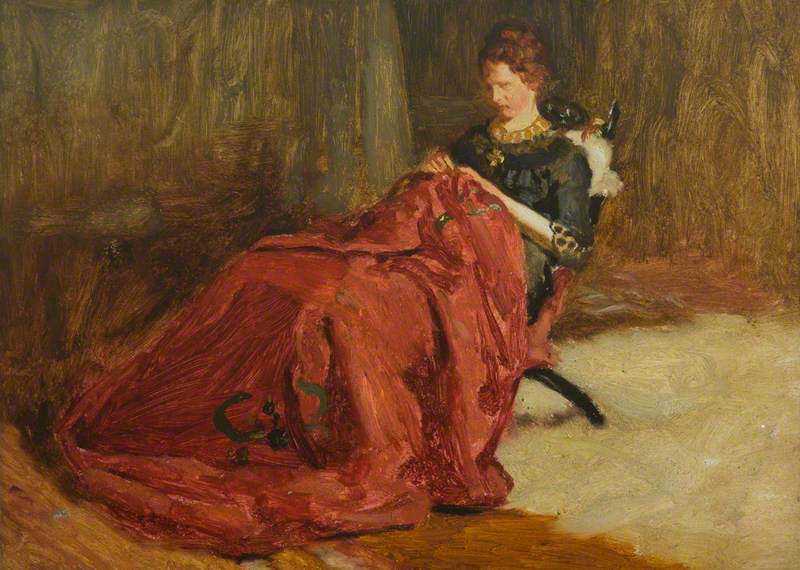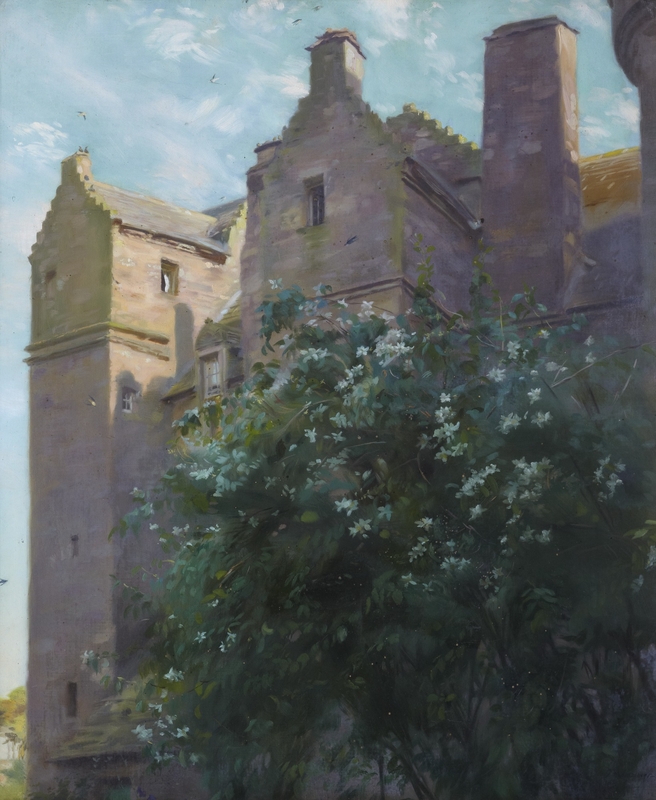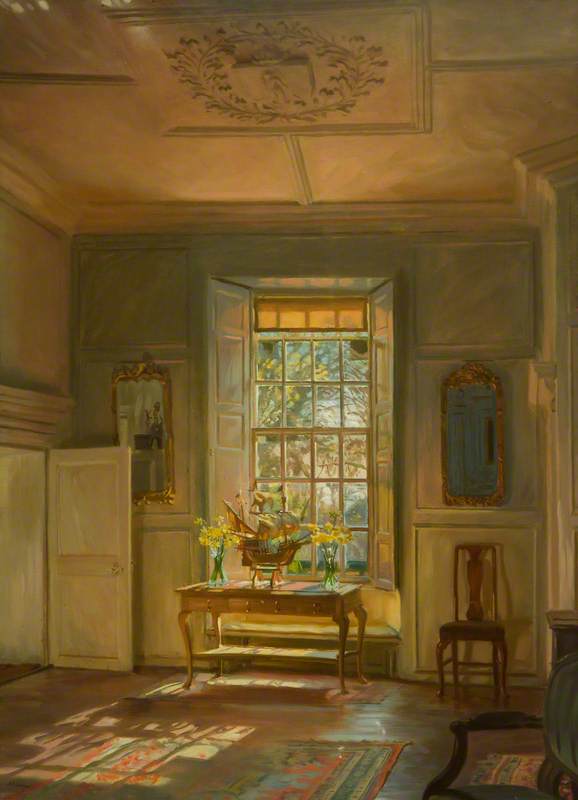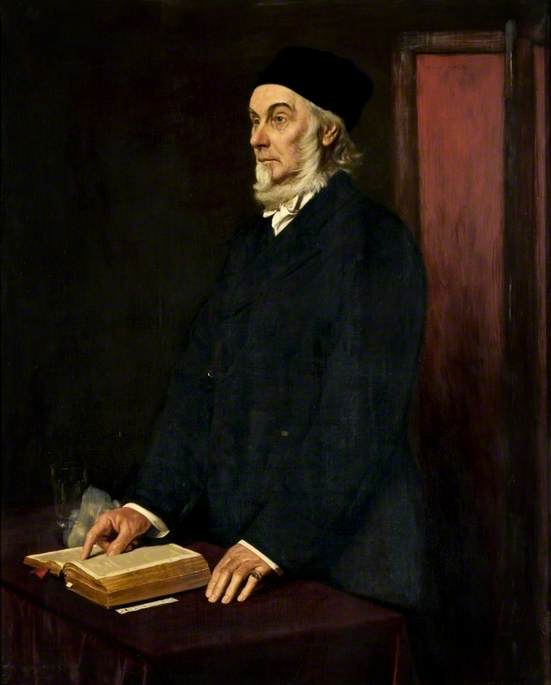This autumn at the City Art Centre in Edinburgh we host a retrospective of John Henry Lorimer's work, exploring Lorimer’s art through five key themes: light, identity, family, femininity and home. Interior scenes of elegant Edwardian family life together with light-filled landscapes are the hallmark of this technically gifted, but somewhat forgotten, artist. In 1878 the Lorimer family acquired the lease of Kellie Castle in Fife, and the castle and its grounds became the subject of many of Lorimer’s paintings.
We have a beautiful and diverse programme of events for this exhibition, visit edinburghmuseums.org.uk.
In this digital exhibition some of our front of house team talk about their favourite works. Curated by Margaret Findlay.
-
John Henry Lorimer with his Dog
John Henry Lorimer was born in Edinburgh, the son of James Lorimer, who was Regius Professor of Public Law at Edinburgh University from 1862-1890. His younger brother was the renowned architect Sir Robert Lorimer, who he sketched and painted throughout his life along with his sisters Hannah, Alice, and Louise. Lorimer's first portrait was of his mother Hannah, completed in 1875 when he was 19. In 1878 the Lorimer family acquired the lease of Kellie Castle in Fife and began its restoration for use as a holiday home. Many of Lorimer's paintings included Kellie Castle as a setting; his studio was in one of the towers and looked out over the garden. Kellie became the permanent family home, after purchase in 1948 by the sculptor Hew Lorimer.
John Henry Lorimer with his Dog
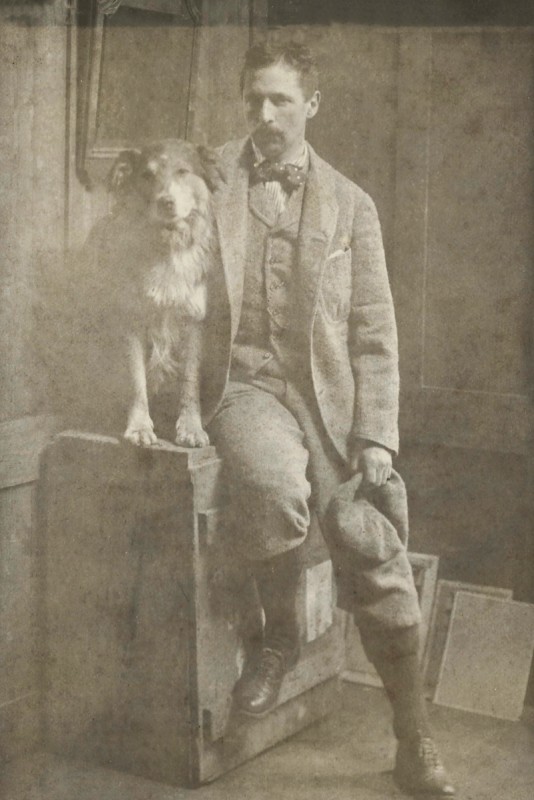 Photo credit: The Lorimer Family
Photo credit: The Lorimer Family
-
Kellie Castle
The oldest parts of Kellie date back to the 14th century, but the whole interior was renovated and re-modelled in the late 19th century by the Lorimers, a famous artistic family. Fairytale stone towers and crow-stepped gables are the flavour of Kellie from the outside, while indoors elaborate plaster ceilings and painted panelling are home to fine furniture designed by Sir Robert Lorimer, who spent much of his childhood at Kellie. The Castle and its romantic Arts & Crafts garden provided inspiration for the paintings of John Henry Lorimer, as well as the real people who walked its corridors and inhabited its rooms.
Kellie Castle
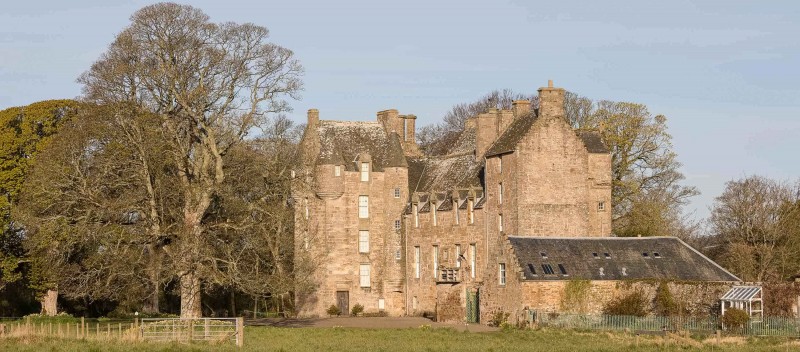 © Nick Haynes. Photo credit: Nick Haynes
© Nick Haynes. Photo credit: Nick Haynes
-
Le peintre des fleurs
Le peintre des fleursKathryn Irvine, Visitor and Monument Assistant Supervisor
This painting is striking. Lorimer has elevated the still life painting by incorporating it with self-portraiture. He has painted a reflection of himself while he works at painting a vase of tulips. You can see that he is deep in concentration. I imagine that Lorimer created this work on a bright spring day. A day on which the sunlight filled his room and played on the objects surrounding him, capturing his imagination and filling him with inspiration.
John Henry Lorimer (1856–1936)
Oil on canvas
H 94.5 x W 56.5 cm
National Trust for Scotland, Kellie Castle & Garden
-
John Henry Lorimer's Studio
John Henry Lorimer's studio is in one of the fairytale towers at Kellie Castle and would have afforded the artist beautiful views over the gardens - a constant source of inspiration for him.
John Henry Lorimer's Studio
 © Nick Haynes. Photo credit: Nick Haynes
© Nick Haynes. Photo credit: Nick Haynes
-
The Long Shadows
The Long Shadows c.1918Amy Orr, Visitor and Monument Assistant
This piece depicts Kellie Castle and its gardens. This location was often a subject in Lorimer’s work as it was where he spent much of his life. Here, we see a group of people working on the gardens in what could be the early morning or evening due to the shadows being cast by the trees, suggesting either a rising or setting sun. Lorimer had a default desire to retreat and enjoyed the peaceful nature of life at Kellie. Here, he observes the workers in the garden, appreciating the beauty of the scenery and perhaps contemplating a simpler life. It is clear that Lorimer had an excellent understanding of light and colour and used this to create idyllic scenes of the landscape he held close to his heart.
John Henry Lorimer (1856–1936)
Oil on canvas
H 102 x W 127 cm
National Trust for Scotland, Kellie Castle & Garden
-
Kellie Castle and Gardens
The Arts and Crafts garden at Kellie Castle was designed by Robert Lorimer in 1880, for his parents. It has gravel and grass paths, box-edged beds, herbaceous borders and old roses. Kellie Castle garden has outstanding value as a Work of Art, it is an early example of Sir Robert Lorimer's work and contains several features designed by other members of the family, particularly his son, the sculptor Hew Lorimer.
Kellie Castle and Gardens
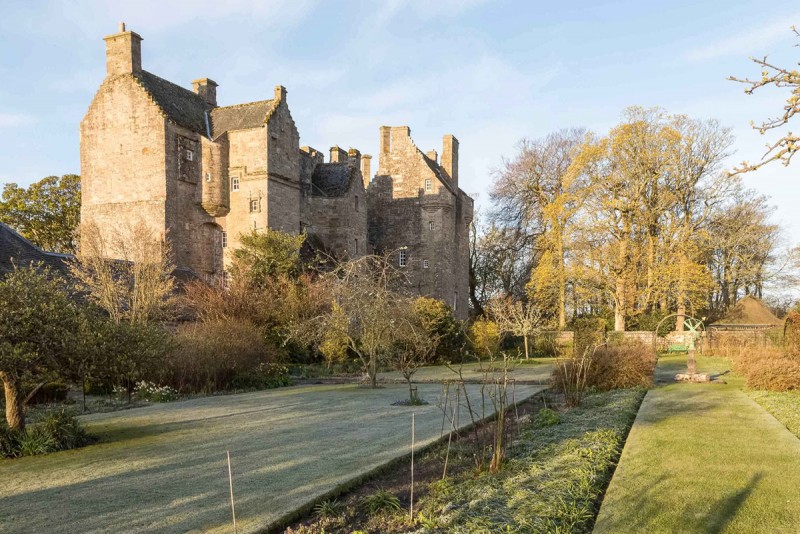 © Copyright Nick Haynes. Photo credit: Nick Haynes
© Copyright Nick Haynes. Photo credit: Nick Haynes
-
Maternal Instinct
Maternal Instinct 1892Roz Third, Visitor and Monument Assistant
Here's a painting that really stands out to me. It depicts an uplifting scene of two women joyfully interacting with a baby, while a young girl looks on. The girl (most likely the baby's older sibling) is holding a doll. I imagine her recreating this scene as she plays, with her in the role of mother and the doll as her baby. On the wall just behind the young girl there appears to be artwork depicting Mary, mother of Jesus, and her young son, further emphasising the maternal theme of the painting. Lorimer uses warm colours and sunlight shining through the windows to create a homely, comfortable scene. Whether you focus on the subject matter or the painting style, this is a beautiful piece.
John Henry Lorimer (1856–1936)
Oil on canvas
H 86.9 x W 112.7 cm
Royal Scottish Academy of Art & Architecture
-
The Flight of the Swallows
The Flight of the Swallows 1906Rachel Weir, Visitor and Monument Assistant
I was drawn to this painting as it reminds me of time spent with family as a child. It brings back memories of summers spent with all the different generations, in our own little world protected from any hardships. As I prepare to leave the family home, I can only imagine I will wave back at them from the other side of the window.
John Henry Lorimer (1856–1936)
Oil on canvas
H 115 x W 89.6 cm
Museums & Galleries Edinburgh – City of Edinburgh Council
-
The Drawing Room at Kellie Castle
The Drawing Room at Kellie Castle today still shows features so clear in the painting 'Flight of the Swallows' held in our City Art Centre collection.
The Drawing Room at Kellie Castle
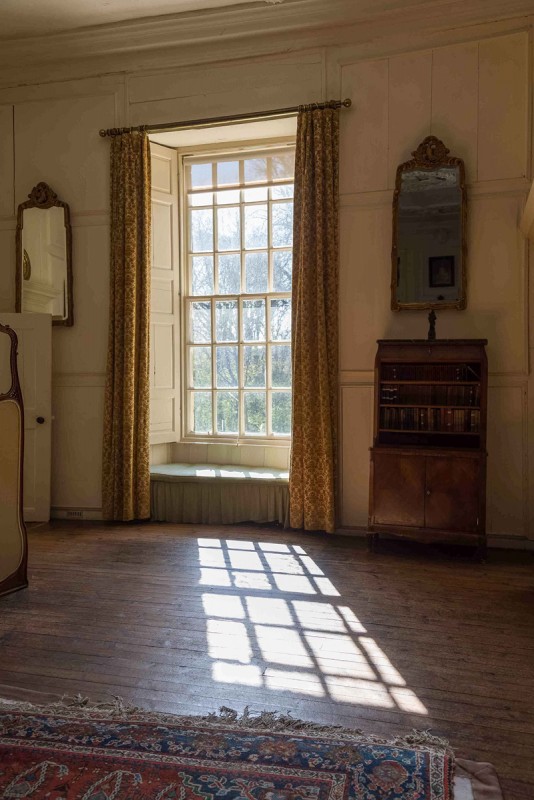 © Nick Haynes. Photo credit: Nick Haynes
© Nick Haynes. Photo credit: Nick Haynes
-
The Drawing Room at Kellie Castle
The Drawing Room at Kellie Castle today still shows features so clear in the painting 'Flight of the Swallows' held in our City Art Centre collection. Today in the rooms we can still imagine the spirits that have inhabited these rooms over the years with all their hopes, dreams and memories.
The Drawing Room at Kellie Castle
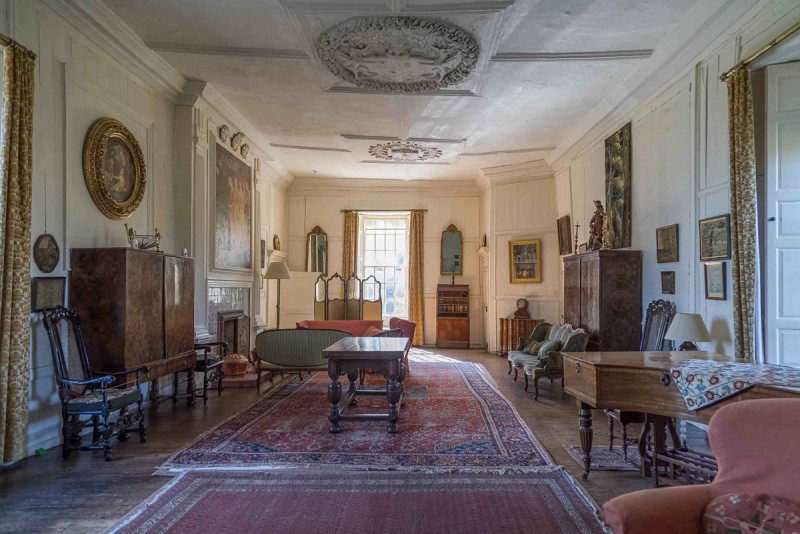 © Nick Haynes. Photo credit: Copyright Nick Haynes
© Nick Haynes. Photo credit: Copyright Nick Haynes
-
Spring Moonlight
Spring Moonlight 1896Fiona Park, Visitor and Monument Assistant
To me this painting is quite wholesome, it shows a mother dancing with her infant child whilst someone plays the piano with a maid standing at the side. You can see the family is wealthy but there is still a sense of closeness and warmth. The colours are quite light with the brightness of the lamps but out the window you can see that it is starting to get darker. The mother’s dress is twirling with her and the painting seems like a window into this moment.
John Henry Lorimer (1856–1936)
Oil on canvas
H 183 x W 130 cm
Fife Council
-
The Drawing Room at Kellie Castle
In 'Spring Moonlight', a mother dances with her baby possibly in this room with its piano and with the light of the moon streaming through the windows. Joy and love emanate from the scene and you can imagine what these walls have seen - with babies growing, dancing and singing.
The Drawing Room at Kellie Castle
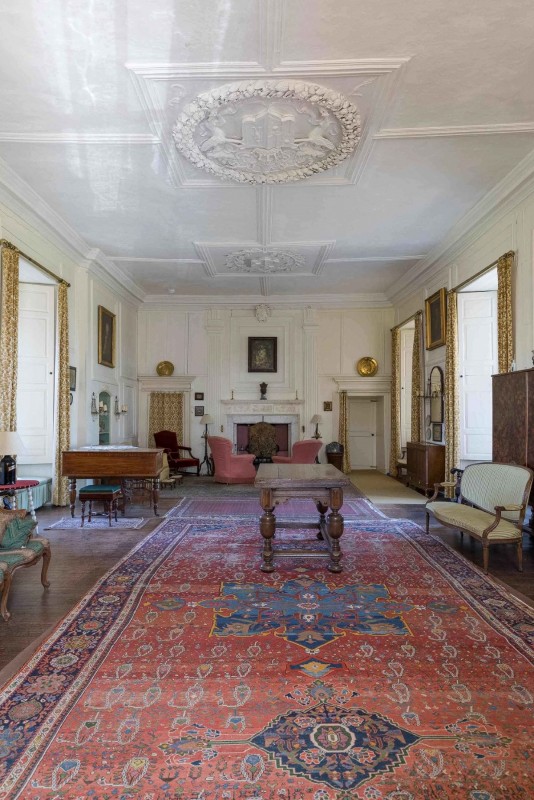 © Nick Haynes. Photo credit: Nick Haynes
© Nick Haynes. Photo credit: Nick Haynes
-
Sir Robert Stodart Lorimer (1864–1929), Architect
Sir Robert Stodart Lorimer (1864–1929), Architect 1886Fiona Fraser, Visitor and Monument Assistant
I am drawn to this painting by the subject as it reminds me of my father who was an architect and who in his later years would still be found at his desk with his drawing board, pens and paper and the same look of concentration as Lorimer. The painting also makes me consider the changes that the Twenty-First Century has brought. My father, born during the lifetime of the architect pictured, would have used the same simple tools – the + square ruler, the board and pens. Yet now an architect, like so many of us, would probably do much of his work on a computer screen. I like to think that there are still architects toiling over their drawing boards pens in hand planning the future.
John Henry Lorimer (1856–1936)
Oil on canvas
H 25.4 x W 35.5 cm
National Galleries of Scotland
-
Conversation Piece, Hannah and Alice Lorimer
Conversation Piece, Hannah and Alice Lorimer 1879Paul Meadows, Visitor and Monument Assistant
Don't be deceived by the photo, Lorimer's painting is full of light and detail. You really need to see this 'in-the-flesh' to appreciate the subtleties: the way the light reflects off the ladies' hair and faces, the detail of their clothes and the mural on the wall behind them, or the way the light creates various shades of green as it reflects off the bowl. My advice to you is come to the City Art Centre to see this beautiful work of art for yourself.
John Henry Lorimer (1856–1936)
Oil on canvas
H 89.5 x W 61 cm
Fife Council
-
Sundown in Spring, Kellie Castle
Sundown in Spring, Kellie CastleAlasdair Stuart, Visitor and Monument Assistant
This painting of Kellie Castle really resonates with me as I grew up near a similar castle in Fife. I spent a lot of time in similar settings. In this painting the castle is used as a backdrop in capturing a pleasant springtime evening. The sun, low in the sky and behind this viewpoint casts mesmerising shadows from the trees on the castle walls. Their trunks lead down towards the door, where vibrant springtime flowers are blooming in contrast to their surroundings. To the fore the stream runs lazily, bringing a sense of tranquillity to the scene.
John Henry Lorimer (1856–1936)
Oil on canvas
H 114.5 x W 89 cm
Fife Council
-
View from Kellie
All of John Henry's paintings of Kellie are saturated in almost ethereal light. The light from the sea adds a mystical appeal and looking from the Kellie to the view over the sea, we can get a real sense of how special this place is. It is easy to see why its spiritual quality inspired generations of Lorimer artists.
View from Kellie
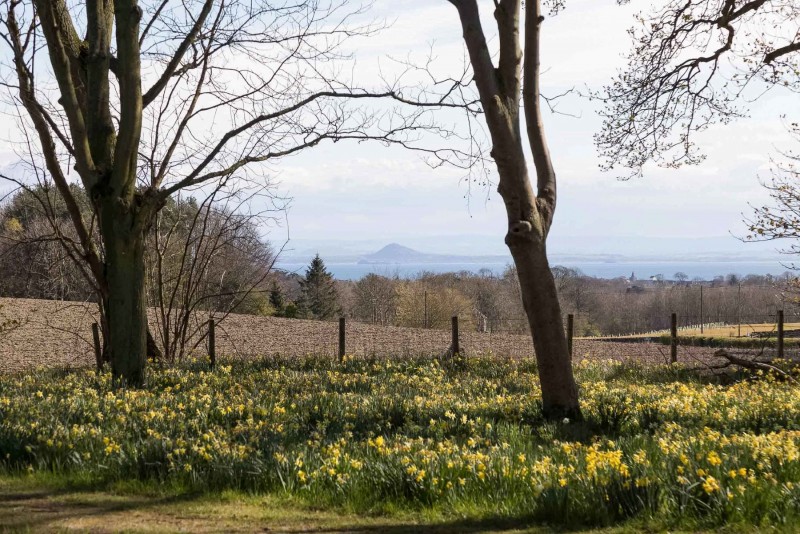 © Nick Haynes. Photo credit: Nick Haynes
© Nick Haynes. Photo credit: Nick Haynes
-
Any Port in a Storm
Any Port in a StormLynn Fulton, Visitor and Monument Assistant
Originally a portrait painter, by 1890 Lorimer’s focus turned to ‘genre’ scenes. The artists home Kellie Castle and its grounds in Fife was a favourite subject and he often revealed aspects of his life there with his family. In this painting the viewer is led through the door and outside into the autumnal day suggested by windswept leaves. However, the mirror suggests that there is also interest further indoors but doesn’t reveal much. The muted colours are brought to life with the addition of complementary colours green and red. The birds take centre stage in the foreground performing their rituals while waiting out the storm in comfort. Their varied body language suggests that they're at ease.
John Henry Lorimer (1856–1936)
Oil on canvas
H 142.5 x W 101.6 cm
National Trust for Scotland, Kellie Castle & Garden
-
Entrance to Kellie Castle
Today the entrance stair at Kellie Castle is almost unchanged as seen in the painting 'Any Port in a Storm'. We can still imagine the rustling leaves, the doves cooing and the wind playing around the castle walls singing its autumn song.
Entrance to Kellie Castle
 © Nick Haynes. Photo credit: Nick Haynes
© Nick Haynes. Photo credit: Nick Haynes
-
Sir Robert Lorimer, ARA, as a Boy
Sir Robert Lorimer, ARA, as a Boy 1875Margaret Lowrey, Visitor and Monument Assistant
I was first attracted to the tenderness expressed in the painting. It is a painting of the artist’s younger brother and the connection is tangible. I was most surprised, however, when I realised that Lorimer was only 19 when he painted the picture as it has a confidence and maturity in the execution. The sure handling of chiaroscuro and of the composition are impressive in such a young man.
John Henry Lorimer (1856–1936)
Oil on canvas
H 54.6 x W 38.1 cm
Tate
-
Hush
Hush 1905–1906Amy Lynch & Emily Sanderson, Retail & Reception Assistants
This painting is a tender portrayal of motherhood which we think will particularly resonate with parents. It depicts the artist’s brother’s wife Violet and first-born son Christopher, who’s just falling asleep. The soft light falling on his face and his mother gazing at him makes you focus your attention on the baby, and the soft white materials feel timeless. There is a protective feel to the painting, created with symbolism like the family dog lying next to the bed and his mother’s hands placed on the baby’s chest. The doves at the window add to this and symbolise peace. The bright and airy lighting and intimate domestic scene creates a lovely image to look at.
John Henry Lorimer (1856–1936)
Oil on canvas
H 101.6 x W 144.8 cm
Rochdale Arts & Heritage Service
-
Blue Room at Kellie
The calm domestic feel in 'Hush' is still evident at Kellie today. Many babies and young children have felt the love and happiness within its walls.
“I do hope we'll see you all at Kellie early next summer...It would be awfully jolly, for Kellie just wants a lot of little kids scampering about to make it perfect.”
- Robert Lorimer to Alice Lorimer
Blue Room at Kellie
 © Nick Haynes. Photo credit: Nick Haynes
© Nick Haynes. Photo credit: Nick Haynes
-
James Lorimer (1818–1890)
James Lorimer (1818–1890) 1878Caroline Lyon, Visitor and Monument Assistant
This 1878 portrait of John Henry’s father suggests an intelligent, studious man. He sits in a favourite chair at Kellie Castle, wearing an academic gown and is engrossed in his vellum bound book. The painting is dark apart from the face and hands, to which the eye is drawn. James Lorimer was well travelled, a professor of public law, had an interest in the arts and architecture and actively promoted the rights and education of women.
John Henry Lorimer (1856–1936)
Oil on canvas
H 127 x W 101.5 cm
University of Edinburgh
-
Hannah Lorimer Embroidering a Bedcover
Hannah Lorimer Embroidering a Bedcover 1885Catriona Mowat, Retail & Reception Manager
This painting by Lorimer for me is quite unusual. In many of his other works there is sumptuous background detail and a focus on the use of light: quite unusually this piece has no detail in the background and no obvious source of natural light present. This draws your eye to Hannah Lorimer immediately and holds it there: I like to think that this shows the affection that Lorimer felt towards his sister. She is engaged in a common activity for the time, and Lorimer has managed to capture the feeling of movement as she embroiders as well as a feeling of intense concentration. Lorimer has a way of enhancing the ordinary to make it special, and for me that is what he has achieved in this piece.
John Henry Lorimer (1856–1936)
Oil on canvas
H 122 x W 240 cm
National Trust for Scotland, Kellie Castle & Garden
-
View of Kellie Castle
View of Kellie CastleAngela Hall, Event Duty Manager
I love this painting of Kellie as it sums up how beautifully romantic and homely the castle is. The foreshortened view contrasted in light and shade emphasises the architecture and the white rose bush dominating the scene adds to the domestic feel. You can just imagine the lives that have lived within the walls and the stories that these rooms can tell.
John Henry Lorimer (1856–1936)
Oil on canvas
H 74.5 x W 61.4 cm
Fife Council
-
Sunlight in the South Room, Kellie
Sunlight in the South Room, Kellie c.1913Gordon Cockburn, Visitor and Monument Assistant
I find this painting striking as Lorimer perfectly captures the golden tranquillity of the sunlight pouring into the stillness of the room bringing the spring daffodils to life. The model ship floats peacefully on the sun’s rays which has a calming effect on the viewer. As both an artist and astronomer, light plays a particularly important role in the work of Lorimer. Kellie is a focal point of inspiration and this painting perfectly captures his love for his surroundings which acted initially as a holiday home during the First World War. The south room perhaps is a place where one could find peace in the simple view from the window as the green trees and flowers bloom in the spring sun.
John Henry Lorimer (1856–1936)
Oil on canvas
H 102 x W 63.5 cm
National Trust for Scotland, Kellie Castle & Garden
-
The Drawing Room at Kellie Castle
Windows are so important in John Henry Lorimer's work, both in terms of reflecting light but in terms of looking out into the world.
The Drawing Room at Kellie Castle
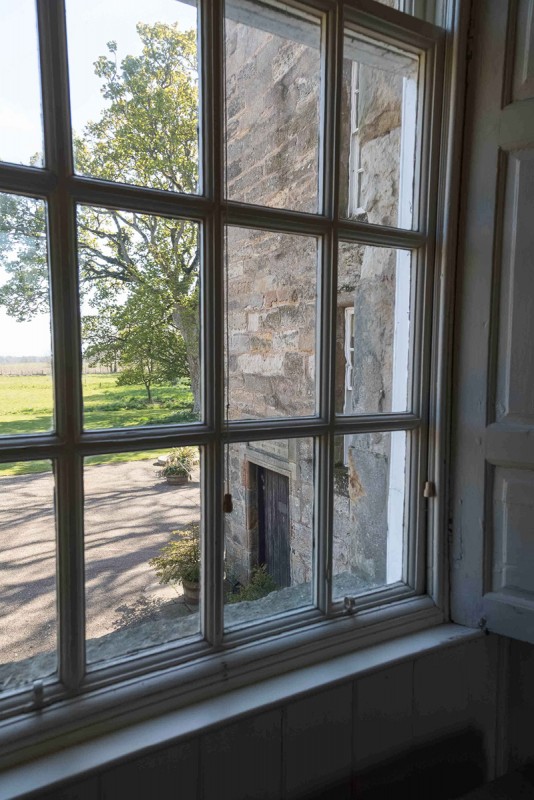 © Nick Haynes. Photo credit: Nick Haynes
© Nick Haynes. Photo credit: Nick Haynes
-
The Ordination of Elders in a Scottish Kirk
The Ordination of Elders in a Scottish Kirk 1891P. McEwan Visitor and Monument Assistant
To me this image reflects religion as theatre. The eponymous supporting cast have gathered around the central characters, the bible and the gesticulating minister, highlighted centrally in the main spotlight. The congregational audience, while barely included around the edges, perform an essential role in supporting the cast and therefore enabling the theatre of religious devotion to be performed.
John Henry Lorimer (1856–1936)
Oil on canvas
H 109.2 x W 140 cm
National Galleries of Scotland
